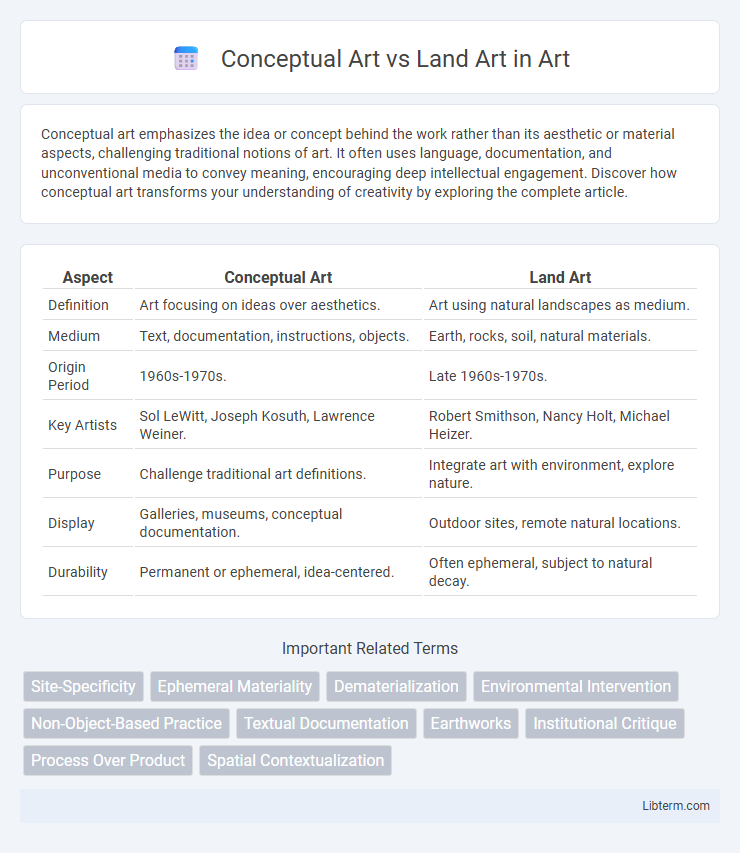Conceptual art emphasizes the idea or concept behind the work rather than its aesthetic or material aspects, challenging traditional notions of art. It often uses language, documentation, and unconventional media to convey meaning, encouraging deep intellectual engagement. Discover how conceptual art transforms your understanding of creativity by exploring the complete article.
Table of Comparison
| Aspect | Conceptual Art | Land Art |
|---|---|---|
| Definition | Art focusing on ideas over aesthetics. | Art using natural landscapes as medium. |
| Medium | Text, documentation, instructions, objects. | Earth, rocks, soil, natural materials. |
| Origin Period | 1960s-1970s. | Late 1960s-1970s. |
| Key Artists | Sol LeWitt, Joseph Kosuth, Lawrence Weiner. | Robert Smithson, Nancy Holt, Michael Heizer. |
| Purpose | Challenge traditional art definitions. | Integrate art with environment, explore nature. |
| Display | Galleries, museums, conceptual documentation. | Outdoor sites, remote natural locations. |
| Durability | Permanent or ephemeral, idea-centered. | Often ephemeral, subject to natural decay. |
Introduction to Conceptual Art and Land Art
Conceptual Art emphasizes the idea or concept behind the artwork, prioritizing intellectual engagement over traditional aesthetic or material concerns. Land Art, also known as Earth Art, involves the creation of art directly within natural landscapes, using natural materials such as soil, rocks, and plants to alter or enhance the environment. Both movements emerged in the 1960s and 1970s, challenging traditional art forms by expanding the definition of art beyond galleries and museums.
Historical Origins and Development
Conceptual Art emerged in the 1960s, emphasizing ideas over aesthetic objects, with pioneers like Sol LeWitt and Joseph Kosuth challenging traditional art forms by prioritizing concepts and language. Land Art, also developing in the late 1960s, originated from artists such as Robert Smithson and Nancy Holt, who created large-scale outdoor works using natural landscapes to challenge gallery conventions. Both movements responded to the cultural and social upheavals of the 1960s, pushing boundaries to redefine the role and context of art in society.
Key Philosophies and Intentions
Conceptual Art emphasizes the primacy of ideas over traditional aesthetic and material concerns, prioritizing intellectual engagement and challenging conventional art definitions. Land Art uses natural landscapes as both medium and context, aiming to reshape environmental perceptions and highlight humanity's relationship with nature through site-specific, often large-scale interventions. Both movements reject commercial art markets, focusing on experiential, often ephemeral expressions that provoke critical reflection.
Major Artists and Influential Works
Conceptual Art, championed by artists like Sol LeWitt and Joseph Kosuth, emphasizes ideas over physical forms, exemplified by LeWitt's "Paragraphs on Conceptual Art" and Kosuth's "One and Three Chairs." In contrast, Land Art involves environmental interventions, with Robert Smithson's "Spiral Jetty" and Michael Heizer's "Double Negative" highlighting large-scale, site-specific works that engage with nature. Both movements redefine artistic boundaries, prioritizing concept and context over traditional aesthetics.
Artistic Methods and Materials
Conceptual Art emphasizes ideas over physical form, often utilizing text, photographs, and installations to challenge traditional artistic boundaries. Land Art involves creating large-scale outdoor works using natural materials such as soil, rocks, and vegetation, integrating the landscape as both medium and context. While Conceptual Art prioritizes intellectual engagement and dematerialization, Land Art centers on environmental interaction and permanence within natural settings.
Relationship with Space and Environment
Conceptual Art emphasizes the primacy of ideas over physical form, often utilizing space as a medium to challenge traditional art boundaries without altering the environment. Land Art, conversely, integrates natural landscapes directly into its creations, transforming and interacting with the environment to highlight ecological processes and spatial context. The relationship with space in Conceptual Art is primarily intellectual and symbolic, while Land Art physically embeds and redefines space through its environmental interventions.
Viewer Engagement and Interpretation
Conceptual Art emphasizes the primacy of ideas over visual aesthetics, encouraging viewers to actively engage with the underlying concepts and challenge traditional art perceptions. Land Art integrates natural landscapes into its medium, inviting observers to experience art through physical interaction and environmental context, often provoking reflection on nature and humanity's relationship. Both forms prioritize interpretation, but Conceptual Art relies more on cognitive engagement whereas Land Art demands sensory and spatial immersion.
Cultural and Social Impact
Conceptual Art challenges traditional art forms by emphasizing ideas over aesthetic objects, fostering intellectual engagement and often critiquing social norms and institutional systems. Land Art creates site-specific works that engage directly with natural landscapes, highlighting environmental concerns and encouraging a deeper cultural connection to place and ecological awareness. Both movements have significantly influenced cultural dialogues by redefining the role of art in society and expanding the boundaries of artistic expression.
Legacy and Contemporary Relevance
Conceptual Art revolutionized the art world by prioritizing ideas over aesthetic objects, influencing contemporary practices in multimedia, installation, and digital art through its emphasis on intellectual engagement. Land Art reshaped environmental aesthetics by integrating natural landscapes into artistic expression, prompting ongoing conversations about ecology, sustainability, and site-specificity in modern art. Both movements left enduring legacies that challenge traditional art forms, encouraging interdisciplinary approaches and critical reflection on art's role in society and nature.
Conceptual Art vs Land Art: Key Differences and Similarities
Conceptual Art emphasizes ideas and concepts over traditional aesthetic and material concerns, often using text, documentation, and ephemeral media, whereas Land Art involves creating large-scale artworks directly within natural landscapes, emphasizing physical interaction with the environment. Both movements challenge conventional art forms and prioritize experience and intention, but Conceptual Art is primarily about intellectual engagement, while Land Art centers on environmental context and spatial transformation. Key similarities include their rejection of traditional gallery spaces and their exploration of art beyond tangible objects.
Conceptual Art Infographic

 libterm.com
libterm.com